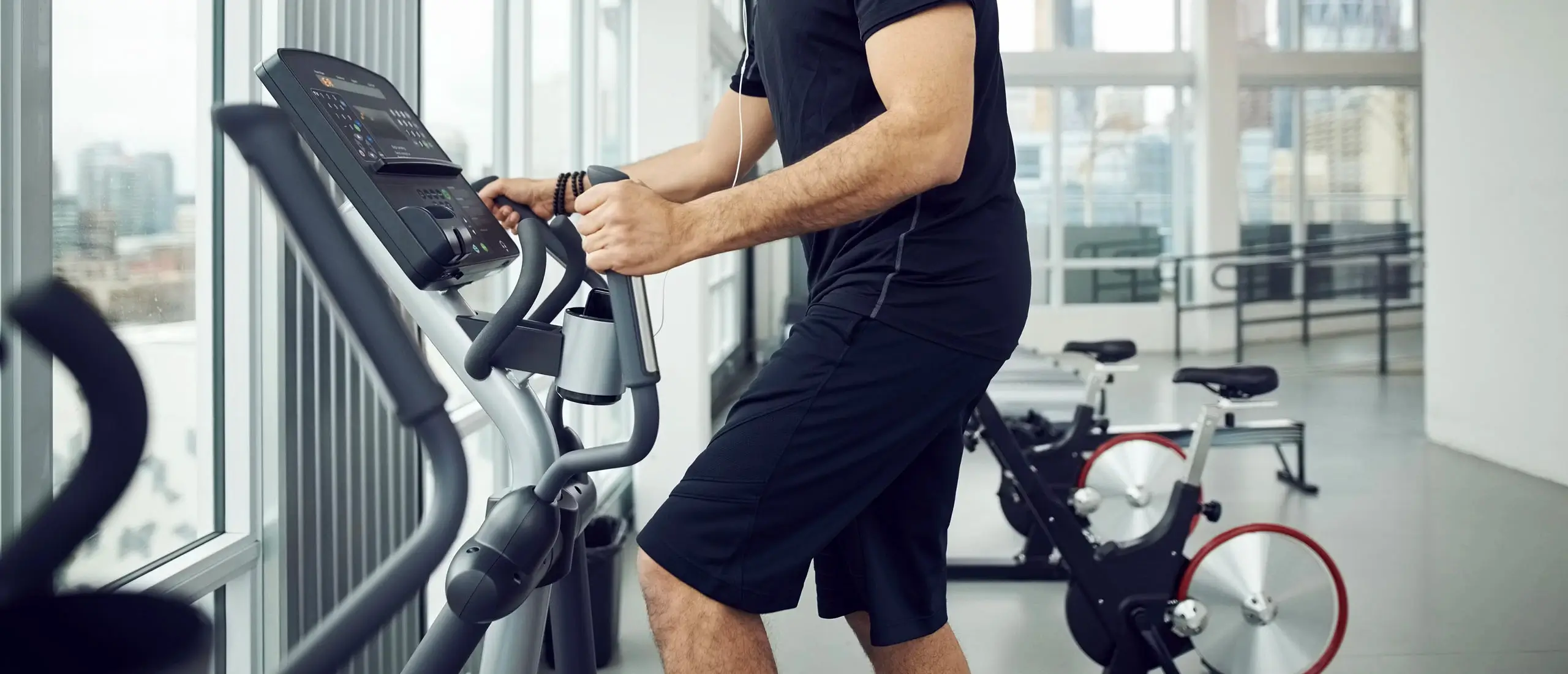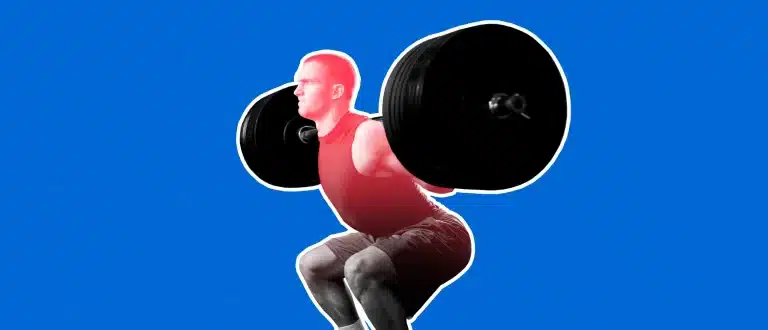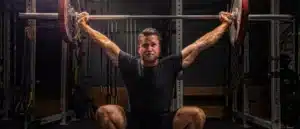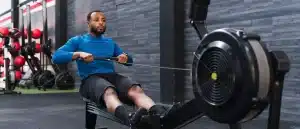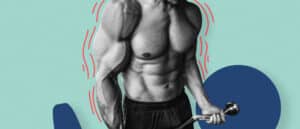Exactly What Muscles Does the Elliptical Target?
For competitive track athletes, the elliptical is either something to be mocked or something you get stuck on when you’re injured. But no matter how “beginner” or “easy” it seems, give it five minutes, and even the most seasoned track athletes who run for hours a day— with ungodly VO2 maxes—will be huffing and puffing.
The elliptical, the pinnacle of absentminded cardiovascular workouts, is a surprisingly effective, full-body workout that combines resistance and cardiovascular training in one. It’s also uniquely weight-bearing (essential for building up the strength of your bones and staving off osteoporosis) and low-impact.
It works both the pushing and pulling muscles of your lower and upper body. And, according to a study published in Gait Posture the elliptical touts substantially greater muscle activation than walking or cycling (1). How many muscles exactly? We get into it below.
What Muscles Does the Elliptical Work?
Ellipticals are credited with working around 80 percent of the muscles in your body. Granted, that’s with proper form. To use the machine correctly, avoid bobbing up and down. Keep your posture upright by bracing your core and pretending like a fishing line is pulling you up through the crown of your head. Face your toes forward, and make sure your knees are tracking directly in front of you (not out or in). With these cues in check, here are the muscles you can expect to hit.
Upper Body
The upper body muscles worked during your time on the elliptical are dictated by how you choose to use the handles at the front of the machine. In theory, the elliptical handles can be pushed forward—which would primarily work the chest, anterior deltoid, serratus anterior, and triceps—and, then pulled backward, placing emphasis on the lats, rhomboids, and traps which help retract the shoulder blades, along with some help from the biceps.
However, in practice, most elliptical users either let their arms ride the poles for free (doing all the work with their legs), or they only push the handles forward and relax on the way back. If you fall in the pusher-only camp, all of the upper body work is performed by the chest, shoulders, and triceps only. If you want to use more upper body muscles, it’s your job to push and pull on the handlebars mindfully.
Muscles Worked: Pectorals (chest), anterior deltoid (front shoulder), latissimus dorsi (lats), serratus anterior, rhomboids, trapezius (traps), triceps, and biceps.
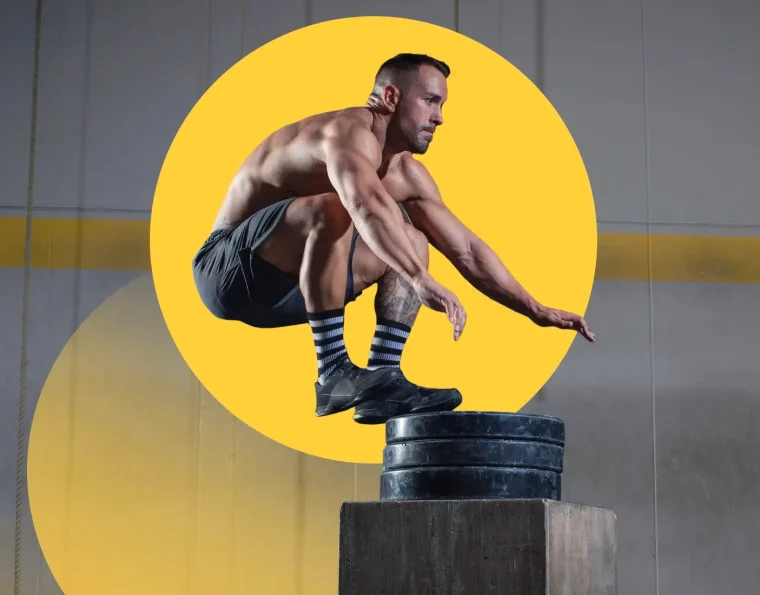
Want exclusive content? Our digests do that.
The best science-backed, expert-driven health and lifestyle content delivered to your inbox, weekly.
Lower Body
Regardless of how you work the handlebars, your legs will be putting in most of the effort. Your glutes, hamstrings, quads, and calves will all be taxed to some extent.
As you push your leg forward, your quads and hip flexors work to flex the knee and lift your leg. As your leg moves back, your glutes and hamstrings will kick on to propel you forward. Throughout the entire range of motion, your abductors (including your glute medius and minimus) and adductors (inner thighs) will work to stabilize your pelvis, while your calves and tibialis anterior contract to stabilize your ankle.
Pro tip: if you’re on a machine with an adjustable incline, crank it up. The higher the incline, the more glute and hamstring activation. In fact, one study found when compared to walking with no incline, walking on a grade of nine degrees resulted in a 635 percent increase in hamstring activation, and 345 percent increase in gluteus maximus contraction (2). You can expect a similar jump on an elliptical.
Muscles Worked: Quadriceps (including hip flexors), glute complex (maximus, minimus, medius), hamstrings, adductors, calves, and anterior tibialis.
Core
Like running or walking, during an elliptical workout, your body relies heavily on your core to stabilize your trunk, maintain good posture, and power your arms and legs. But when we say “core,” we’re not just talking about the abs, we mean all muscles that work in harmony to stabilize your spine.
The heavy hitters are the muscles that contract around your spine like your abs, obliques, and lower back. Contracting the muscles around your spine together to create a rigid midsection is called abdominal bracing and protects your spine from moving into a position that could damage your spinal cord, vertebrae, or nerves. Think of abdominal bracing like a standing plank—the goal is to maintain that same strong, stable posture through the spine, while your arms and legs do all the moving.
Technically, your core also includes the hip flexors and glutes mentioned above which work to stabilize the pelvis. Without a stable pelvis, you can’t have a stable spine. As you pedal, your abs and glute muscles work together to maintain a slightly tucked, neutral pelvis—which minimizes excessive arching of the lower spine (and associated potential injuries).
Muscles Worked: Rectus abdominus, transverse abdominus, external and internal obliques, quadratus lumborum, and erector spinae.
But, Does an Elliptical Build Muscle?
Surprisingly, yes, aerobic exercise can build lean muscle. According to a review of research, published in Exercise Sport Science Review, there’s considerable evidence that cardio, like using the elliptical, can result in muscle hypertrophy (or growth) (3).
Don’t confuse a whirl on the elliptical for a strength workout, though. Sure, it’s a great way to build muscular endurance, and you can crank up the resistance to challenge your muscles a little more. Just don’t expect the elliptical to work your chest anywhere close to the chest-pumping potential of Don Saladino’s cable fly superset.
What’s the Downside?
Ellipticals make for a safe cardio workout that targets a fat stack of muscles, but it’s not all great. For one thing, they’re a little boring—but that’s nothing a little RedZone can’t fix. The real issue is that they’re not ideal for people of different sizes.
Ellipticals are designed for someone of average size. The arms and legs don’t adjust for super tall or short people. If you’ve ever felt awkward on an elliptical (raises hand) it’s probably not the right size for you. And unless you’re purchasing an elliptical for your home gym—which thankfully come in variable sizes—you’re stuck with whatever’s at the gym.
This is exactly why, as a trainer, I would never force a client to use an elliptical if they were uncomfortable. By all means, try it. Just know other options are there if you need them. For an adjustable low-impact option try rowing or cycling, and for more freedom of movement try a treadmill or stair stepper.
3 Elliptical Workouts From a Certified Trainer
In my ten years as a trainer I’ve been asked to do quite a few things: one of them being to instruct elliptical classes. Here are the workouts I suggest to build muscle, boost cardio, and get a great training session on your trusty elliptical.
Slow and Steady
Zone 2 cardio can boost your cardiovascular health, weight loss, mitochondrial health (4), VO2 max, mood, and more. Ideally, it should make up about 80 percent of your cardiovascular routine, while the other 20 percent can be reserved for fun stuff like intervals and HIIT.
- 30 minutes or more in Zone 2 (60-70% of your max heart rate)
30-Minute HIIT Workout
Nothing beats HIIT for calorie-burning potential. By breaking workouts into periods of intense work followed by rest, you push your body to work on less oxygen than it needs. After your workout, your body works overtime, burning more calories to return to homeostasis (also called EPOC or excess post-exercise oxygen consumption). Here’s how to do it.
- 5:00 warmup
- 0:10 pace build-up, 0:20 all-out sprint, 1:30 easy pace or total rest (repeat ten times)
- 5:00 cooldown
30-Minute Interval Workout
If you thought sprints were hard, give this Fartlek-style interval workout a try. With sprints, you’re typically allotted a block of time to fully recover, but with Fartlek training, the aim is to keep the body moving for the entire workout. To up the ante, tack on some incline during the one-minute all-out push.
- 5:00 warmup
- 3:00 moderate pace, 1:00 all-out pace, 2:00 easy pace (repeat five times)
- 5:00 cooldown
Hone’s testosterone assessment is the simplest way to uncover whether your levels are low. It’s fast, simple, and you can do it from home. And if low T is the problem, Hone can help you get you back on top of your game.
FAQs About Ellipticals
You’ve got questions about ellipticals, we’ve got answers.
Can You Get Toned on an Elliptical?
Toning is a buzzword that refers to getting leaner or burning fat. Ellipticals help your body burn calories, which can help with weight loss and fat reduction when combined with a healthy diet (either calorie-controlled, macro-controlled like keto or intermittent fasting). You’ll get even better results when you pair it with a regular resistance training regimen.
What Does 30 Minutes on an Elliptical Do?
The average 30-minute elliptical session can burn around 270 to 378 calories depending on your body weight, according to Harvard Medical School. It will also improve your cardiovascular endurance, whether you mindlessly plug and chug or rock an intense HIIT workout.
Are Ellipticals Good For Burning Belly Fat?
Like other cardio workouts, an elliptical workout will help you achieve a calorie burn, which can help you burn body fat when done as a part of your regular routine. However, it’s impossible to choose where you lose fat first (regardless of what kind of workout you do). Stick to it, tweaking your workouts and diet as needed. Over time you’ll cut fat in your belly and other areas of your body, too.
References
1. Prosser, L. et al (2012). Comparison of elliptical training, stationary cycling,, treadmill walking and overground walking. https://www.ncbi.nlm.nih.gov/pmc/articles/PMC3299003/
2. Franz, J. et al (2013). The Effects of Grade and Speed on Leg Muscle Activations during Walking. https://www.ncbi.nlm.nih.gov/pmc/articles/PMC3262943/
3. Konopka, A. et al (2014). Skeletal Muscle Hypertrophy after Aerobic Exercise Training. https://www.ncbi.nlm.nih.gov/pmc/articles/PMC4523889/
4. Huertas, J. et al (2019). Stay Fit, Stay Young: Mitochondria in Movement: The Role of Exercise in the NewMitochondrial Paradigm. https://www.ncbi.nlm.nih.gov/pmc/articles/PMC6607712/



